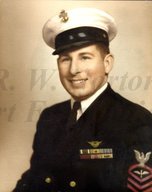
|

|
|
|
|
Hewitt was born in Duplessis, Louisiana in Ascension Parish, about 15 miles south of Baton Rouge or more specifically, he says, of Tiger Stadium at LSU. He was one of 9 children of Hendrick and Irene Bevin LeBlanc. The LeBlanc home was a 10-acre farm with a grist mill and a bean thrasher. Hendrick built the home and supplemented his income by working as a carpenter. While his father helped build Fort Polk, Hewitt and a brother took care of the farm. Hewitt ran the grist mill. They also grew strawberries, which were shipped to Hammond for auction. The family's main diet consisted of cornbread, beans, rice, meat, gravy, and jambalaya. Hewitt and his brother also caught crawfish for the family table. The LeBlancs attended St. Theresa's Catholic Church in Gonzales, about three miles from their home. Hewitt graduated from Gonzales High School in March of 1941. On May 23, 1941 he joined the navy, mainly out of his love of geography and a desire to travel. Hewitt completed boot camp at San Diego Naval Base, then Aviation Machinist Trade School at nearby North Island Naval Air Station. He received orders to Pearl Harbor and was to sail on December 7; the Japanese attack, however, delayed the voyage by several days. He arrived at Pearl Harbor the afternoon of Christmas Eve of 1941. "It was a mess," he says of the aftermath of the Japanese attack. Hewitt was assigned to Kaneohe Naval Air Station across the island from Pearl Harbor. For 44 days he helped guard an aircraft hangar. Then a personnel officer asked him if he'd like to come work in the commanding officer's office. He was soon promoted to E4 and also drew flight pay. Hewitt flew aboard PBYs behind the pilot as a lookout. The flights (he flew just once a month) lasted about "seven or eight hours". In the office he spent the day answering the telephone and running errands for the CO. Hewitt then went to aero gunnery school. He was assigned to a plane crew as a .50 mm starboard waist gunner and sent to Midway, arriving there soon after the Battle of Midway. As part of Patrol Squadron 12P9, he flew patrols ranging about 700 miles. Of all those he flew, his plane exchanged fire with only one enemy aircraft--a Japanese bomber, on September 16, 1942. Most of the patrol missions lasted about 10 hours. In November he sailed from Pearl Harbor to the Fiji Islands. There he continued to fly patrols before his group was sent to Henderson Field on Guadalcanal where he flew night reconnaissance flights. They also did night bombing raids on Bougainville. On Guadalcanal he lived in a tent, with a foxhole beside it. By June of 1943 Hewitt was back in Honolulu before returning to the States. He was assigned to Saufley Field in Pensacola, Florida. By then he was an E7 and had decided to spend a career in the Navy. He was in Pensacola when the war ended. There he married Genevieve DeFatta on August 24, 1945. (They would have four children.) He later returned to the Pacific as part of a transportation squadron. By 1948 he was stationed in Tokyo, where he found conditions safe and the citizens friendly. "I would go out in Tokyo, say even at night and just walk down the street...and I was not afraid of anything. And they were all really nice and courteous," he recalls. Hewitt retired on August 1, 1961 and moved the family to Shreveport, Genevieve's hometown. He began working at Sears & Roebuck in February of 1962, then with GNB Batteries, where he worked for nearly 20 years in charge of the chemistry laboratory. |


